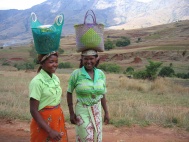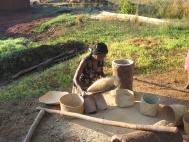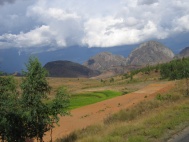Difference between revisions of "Betsileo"
CampMaster (talk | contribs) m (Reverted edits by 208.74.31.116 (Talk) to last revision by MissMada) |
|||
| (9 intermediate revisions by 2 users not shown) | |||
| Line 1: | Line 1: | ||
Betsileo literally means ''The many invincibles''. About 12% of the population of Madagascar are Betsileo. The majority of them live in the central highlands south of the [[Merina]] around [[Fianarantsoa]]. About 150,000 have their home in the Betsiboka region. | Betsileo literally means ''The many invincibles''. About 12% of the population of Madagascar are Betsileo. The majority of them live in the central highlands south of the [[Merina]] around [[Fianarantsoa]]. About 150,000 have their home in the Betsiboka region. | ||
| − | [[File:Betsileo_01.jpg|600px|none|thumb|Betsileo man near | + | [[File:Betsileo_01.jpg|600px|none|thumb|Betsileo man in the early morning hours near [[Morarano]] village]] |
| − | The Betsileo culture is similar to their Merina neighbours. The Betsileo are reputedly the best farmers in Madagascar and therefore well known for their very good knowledge of rice cultivation. Irrigated, terraced rice paddies are characteristic scenery around Betsileo villages. Men are traditionally wrapped in colourful blankets, women have often shiny gold teeth. Single boys will | + | The Betsileo culture is similar to their Merina neighbours. The Betsileo are reputedly the best farmers in Madagascar and therefore well known for their very good knowledge of rice cultivation. Irrigated, terraced rice paddies are characteristic scenery around Betsileo villages. Men are traditionally wrapped in colourful blankets, women have often shiny gold teeth. Single boys will place a comb in their hair, whilst single girls will use hair clips to inform potential partners that they are available. |
<table cellpadding="0" cellspacing="0" border="0" style="margin-right:10px;"><tr> | <table cellpadding="0" cellspacing="0" border="0" style="margin-right:10px;"><tr> | ||
| Line 11: | Line 11: | ||
<table cellpadding="0" cellspacing="0" border="0" style="margin-right:10px;"><tr> | <table cellpadding="0" cellspacing="0" border="0" style="margin-right:10px;"><tr> | ||
| + | <td valign="top">[[Image:Betsileo_05.jpg|189px|none|thumb|Betsileo woman sorting out the rice]]</td> | ||
<td valign="top">[[Image:Betsileo_rice_field_01.jpg|189px|none|thumb|Terraced rice field]]</td> | <td valign="top">[[Image:Betsileo_rice_field_01.jpg|189px|none|thumb|Terraced rice field]]</td> | ||
| − | <td valign="top">[[Image: | + | <td valign="top">[[Image:Betsileo_06.jpg|189px|none|thumb|Betsileo women pounding the rice]]</td></tr></table> |
| − | |||
| − | The ceremony of [[Famadihana]] - ''turning of the bones'' was introduced to the Betsileo people by the Merina during the time of Queen {{nowrap begin}}Ranavalona I.{{nowrap end}} Like many other ethnical groups, | + | The ceremony of [[Famadihana]] - ''turning of the bones'' - was introduced to the Betsileo people by the Merina during the time of Queen {{nowrap begin}}Ranavalona I.{{nowrap end}} Like many other ethnical groups, the Betsileo are also superstitious. For example, it is [[fady]] to start a meal before the father or the most honourable person is present. For a husband it is fady to wear a lamba (traditional blanket) thrown over his shoulder during the pregnancy of his wife. |
| + | |||
| + | <table cellpadding="0" cellspacing="0" border="0" style="margin-right:10px;"><tr> | ||
| + | <td valign="top">[[Image:Betsileo_07.jpg|189px|none|thumb|[[Morarano]] village in the Tsaranoro valley]]</td> | ||
| + | <td valign="top">[[Image:Betsileo_08.jpg|189px|none|thumb|Traditional Betsileo house]]</td> | ||
| + | <td valign="top">[[Image:Betsileo_09.jpg|189px|none|thumb|Young Betsileo woman]]</td></tr></table> | ||
Latest revision as of 05:32, 16 July 2011
Betsileo literally means The many invincibles. About 12% of the population of Madagascar are Betsileo. The majority of them live in the central highlands south of the Merina around Fianarantsoa. About 150,000 have their home in the Betsiboka region.

The Betsileo culture is similar to their Merina neighbours. The Betsileo are reputedly the best farmers in Madagascar and therefore well known for their very good knowledge of rice cultivation. Irrigated, terraced rice paddies are characteristic scenery around Betsileo villages. Men are traditionally wrapped in colourful blankets, women have often shiny gold teeth. Single boys will place a comb in their hair, whilst single girls will use hair clips to inform potential partners that they are available.
The ceremony of Famadihana - turning of the bones - was introduced to the Betsileo people by the Merina during the time of Queen Ranavalona I. Like many other ethnical groups, the Betsileo are also superstitious. For example, it is fady to start a meal before the father or the most honourable person is present. For a husband it is fady to wear a lamba (traditional blanket) thrown over his shoulder during the pregnancy of his wife.
 Morarano village in the Tsaranoro valley |







